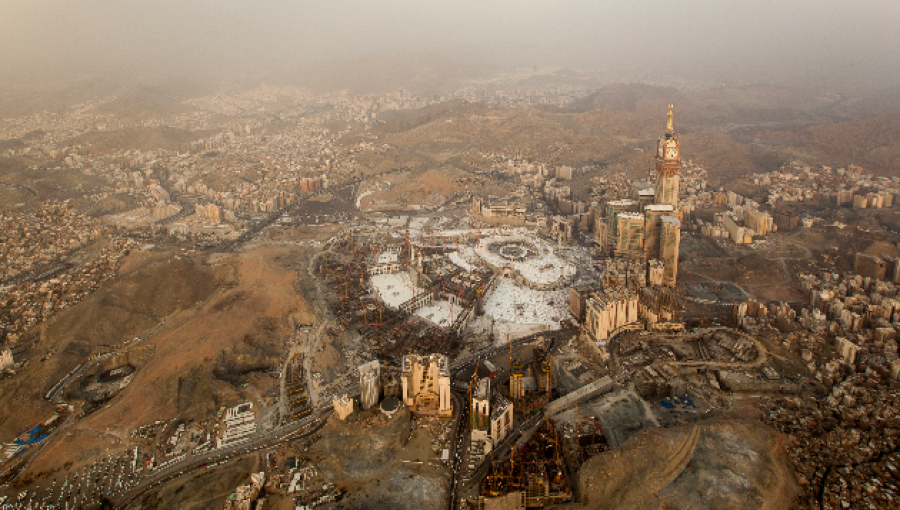The Al Masjid Al Haram, also referred to as the Grand Mosque or Masjid al-Haram, stands as the most sacred site in Islam and a pivotal symbol of faith for Muslims globally. Located in the revered city of Mecca in Saudi Arabia, this magnificent mosque has played a central role in Islamic history and devotion for over 14 centuries.
The mosque's focal point is the Kaaba, a simple cubic structure enveloped in black cloth, representing the holiest site in Islam. Encircled by pilgrims during the annual Hajj and Umrah pilgrimages, the Kaaba holds profound significance as Muslims worldwide turn toward it during daily prayers.
Al Masjid Al Haram is distinguished not only by its spiritual role but also by its architectural grandeur. With a capacity to accommodate up to 2.5 million worshippers, it is the largest mosque globally. The mosque's history reflects centuries of religious devotion, architectural marvels, and artistic splendor, embodying the essence of Islamic civilization.
For Muslims, visiting the Grand Mosque is a lifelong aspiration and a profound spiritual journey. The mosque's enduring significance underscores its integral role in Islamic culture, serving as a timeless symbol of unity and faith for millions of believers around the world.
Historical Origins and Construction
The origins of Al-Masjid Al-Haram trace back to the time of the Prophet Ibrahim (Abraham) and his son Isma'il (Ishmael), according to Islamic tradition. It is believed that Ibrahim and Isma'il were inspired by divine command to construct the Kaaba, a simple cubic structure that serves as the focal point of the mosque. Over time, the site grew in importance, evolving into the magnificent mosque complex that we see today.
.jpg)
Historical records indicate that significant expansions and renovations to Al-Masjid Al-Haram occurred under various Muslim rulers and caliphs. Caliph Omar Ibn al-Khattab played a pivotal role in expanding the mosque during the 7th century CE. Subsequent dynasties, including the Umayyads, Abbasids, and Ottomans, further embellished and enlarged the mosque, reflecting the evolving architectural styles and religious ambitions of Islamic civilization.
Purpose and Significance
Al-Masjid Al-Haram serves as the ultimate pilgrimage destination for Muslims worldwide. It is the focal point towards which all Muslims face during their daily prayers (salah) as a symbol of unity and devotion. The mosque hosts the annual Hajj pilgrimage, one of the Five Pillars of Islam, where millions of Muslims from around the globe gather to perform religious rites and seek spiritual fulfillment.
The significance of Al-Masjid Al-Haram extends beyond religious practice. It is a center of Islamic scholarship, attracting theologians, scholars, and students who seek to deepen their understanding of Islam's teachings and principles. The mosque also embodies a sense of communal identity and unity among Muslims, fostering a shared connection to their faith and heritage.
Structure and Architectural Design
Al-Masjid Al-Haram is a sprawling complex covering approximately 356,800 square meters. Its architectural design reflects a harmonious blend of traditional Islamic elements and modern innovations. At the heart of the mosque lies the Kaaba, draped in a black silk cloth (kiswa) adorned with gold calligraphy—an object of veneration for Muslims worldwide.
Read: Masjid al-Nabawi: A Jewel of Islamic Heritage
The mosque's interior is adorned with exquisite artwork and craftsmanship. Elaborate calligraphy featuring verses from the Quran adorns the walls and pillars, conveying spiritual messages and enhancing the atmosphere of reverence. Intricate geometric patterns and arabesque motifs decorate the floors and ceilings, symbolizing the beauty and complexity of Islamic art.
Artistry and Design
The artistry of Al-Masjid Al-Haram is a testament to Islamic cultural heritage and aesthetic excellence. Skilled artisans have meticulously crafted the mosque's interior with a focus on precision and spiritual symbolism. The use of materials such as marble, gold, and precious stones adds to the grandeur and sanctity of the space.

One of the most revered features of the mosque is the Black Stone (Hajar al-Aswad), embedded in the eastern corner of the Kaaba. According to tradition, this stone was given to Ibrahim by the angel Gabriel and is kissed or touched by pilgrims during Hajj and Umrah, symbolizing purification and unity.
Importance to Muslim Society and Islam
Al-Masjid Al-Haram holds profound importance for Muslims, serving as a source of spiritual inspiration and communal unity. It embodies the core tenets of Islam, including faith, submission, and devotion to Allah. The annual pilgrimage to Mecca is a transformative experience for millions of Muslims, reinforcing bonds of faith and strengthening their connection to the global Muslim community.
Read: The Dome of the Rock: A Monument of Faith and History
In conclusion, Al-Masjid Al-Haram stands as a symbol of Islamic faith, architectural brilliance, and cultural heritage. Its history, purpose, and design reflect the enduring legacy of Islam and its profound impact on civilization. The mosque continues to inspire and unite Muslims from diverse backgrounds, underscoring the universal principles of peace, unity, and devotion that define the Islamic faith.































Comment: